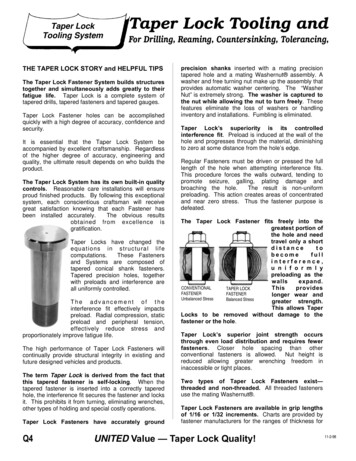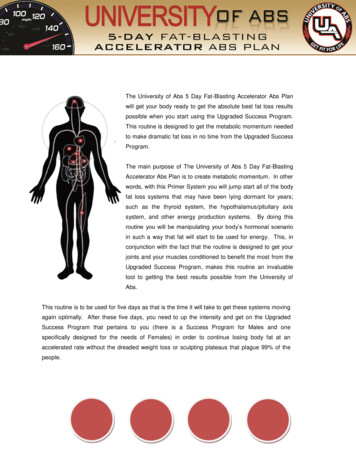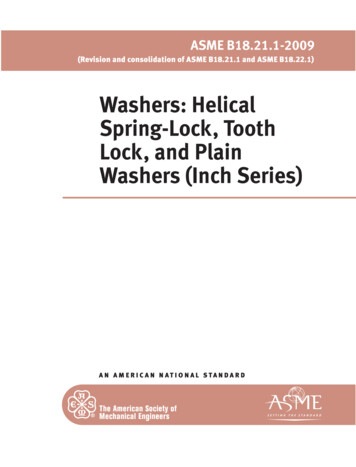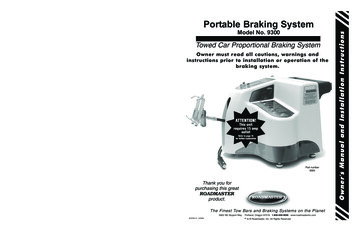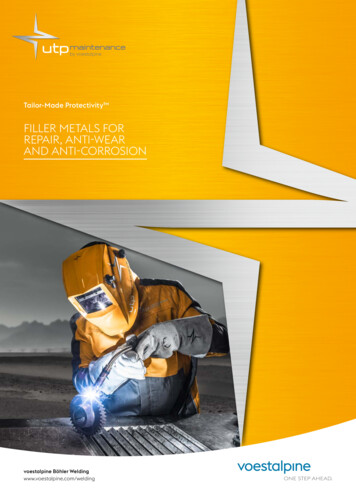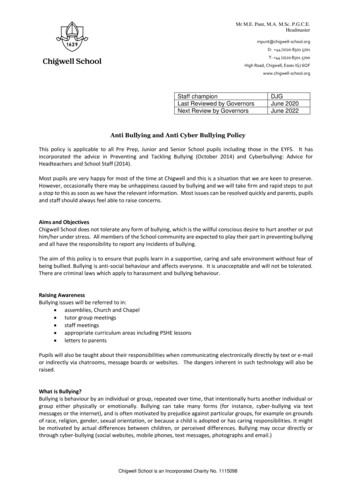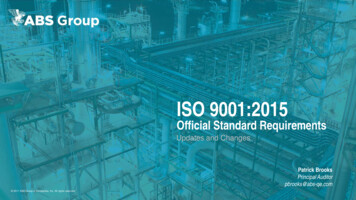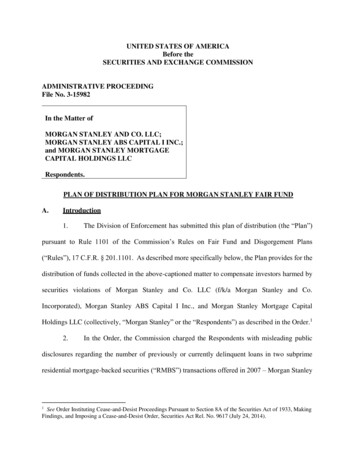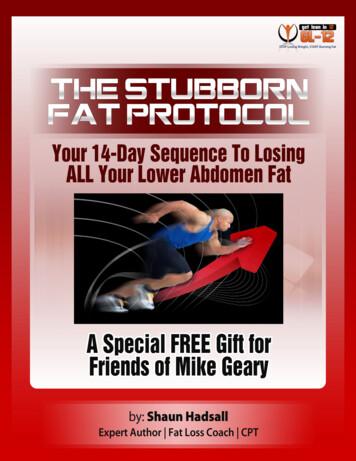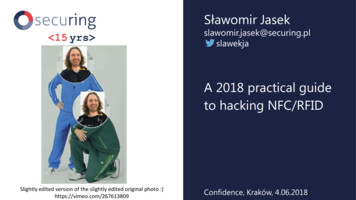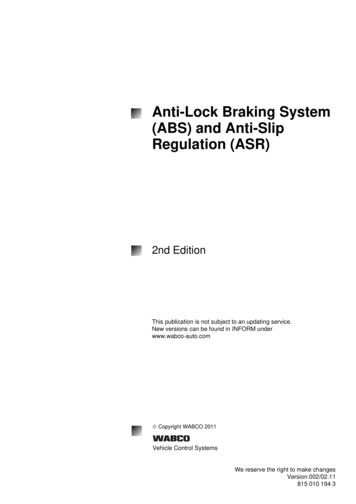
Transcription
Anti-Lock Braking System(ABS) and Anti-SlipRegulation (ASR)2nd EditionThis publication is not subject to an updating service.New versions can be found in INFORM underwww.wabco-auto.com Copyright WABCO 2011Vehicle Control SystemsWe reserve the right to make changesVersion 002/02.11815 010 194 3
ABS TrainingTable of contentsAnti-Lock Braking System (ABS) . . . . . . . . . . . . . . . . . . . . . . . . . . . . . . . . . 3Anti-Slip Regulation (ASR) . . . . . . . . . . . . . . . . . . . . . . . . . . . . . . . . . . . . . . 4RSC and ESC . . . . . . . . . . . . . . . . . . . . . . . . . . . . . . . . . . . . . . . . . . . . . . . . 5Development . . . . . . . . . . . . . . . . . . . . . . . . . . . . . . . . . . . . . . . . . . . . . . . . . 6Theoretical ABS basics . . . . . . . . . . . . . . . . . . . . . . . . . . . . . . . . . . . . . . . . . 7Theoretical ASR basics . . . . . . . . . . . . . . . . . . . . . . . . . . . . . . . . . . . . . . . . . 8Operation of the ABS . . . . . . . . . . . . . . . . . . . . . . . . . . . . . . . . . . . . . . . . . . 9Operation of ASR . . . . . . . . . . . . . . . . . . . . . . . . . . . . . . . . . . . . . . . . . . . . 11ABS and ASR components . . . . . . . . . . . . . . . . . . . . . . . . . . . . . . . . . . . . . 14Structure of an EC Air Braking System with ABS / ASR fittedin the towing vehicle . . . . . . . . . . . . . . . . . . . . . . . . . . . . . . . . . . . . . 15Structure of an air braking system with ABS E (with ESC/RSC)and ASR in the towing vehicle . . . . . . . . . . . . . . . . . . . . . . . . . . . . . 16Structure of an EC Air Braking System with ABS fittedin the trailer / semitrailer . . . . . . . . . . . . . . . . . . . . . . . . . . . . . . . . . . 17Electronic Control Unit (ECU) 446 003/004 . 0on the towing vehicle . . . . . . . . . . . . . . . . . . . . . . . . . . . . . . . . . . . . 18VARIO-C Control Unit for Trailer ABS 446 105 . 0 . . . . . . . . . . . . . 20VARIO Compact ABS (VCS) for trailers . . . . . . . . . . . . . . . . . . . . . . 21VARIO Compact ABS 2. Generation (VCS II) for trailers . . . . . . . . . 22Rod sensor 441 032 . 0 and pole wheel . . . . . . . . . . . . . . . . . . . . . 23ABS Solenoid Valves 472 195 . 0 . . . . . . . . . . . . . . . . . . . . . . . . . . 25ABS solenoid relay valve 472 195 02 . 0 or 472 195 04 . 0 . . . . . . . 27Additional components for ASR . . . . . . . . . . . . . . . . . . . . . . . . . . . . 29Special functions of the ABS . . . . . . . . . . . . . . . . . . . . . . . . . . . . . . . . . . . . 31Testing the Anti-Lock Braking System (ABS) . . . . . . . . . . . . . . . . . . . . . . . 32Safety circuit, component fault detection and measures to be taken 32The warning lamps (previously also called safety lamps) . . . . . . . . . 33Diagnosis . . . . . . . . . . . . . . . . . . . . . . . . . . . . . . . . . . . . . . . . . . . . . . . . . . 3522
Anti-Lock Braking System (ABS)ABS TrainingAnti-Lock Braking System (ABS)PurposeAnti-lock brake systems (ABS) - generally also referred to as anti-locksystems (ALS) - are designed to prevent the vehicle wheels from lockingas a result of the service brake being applied with too much force, especially on slippery road surfaces.The idea is to maintain cornering forces on braked wheels to ensure thatthe vehicle or vehicle combination retains its driving stability and manoeuvrability as far as physically possible. The available power transmission or grip between tyres and carriageway should also be utilised asfar as possible to minimise the braking distance and maximise vehicledeceleration.Why ABS?Although today commercial vehicle brakes are designed to a very hightechnical standard, braking on slippery roads often results in potentiallydangerous situations. During full or even partial braking on a slipperyroad it may no longer be possible to fully transfer the braking force ontothe road due to the low coefficient of friction (friction coefficient (k)) between the tyres and the carriageway. The braking force is excessive andthe wheels lock up. Locked wheels no longer provide any grip on theroad and are almost incapable of transferring any cornering forces(steering and tracking forces). This often has dangerous consequences:– The vehicle becomes unsteerable– The vehicle breaks away in spite of countersteering, and starts toswerve.– The braking distance is significantly increased– Tractor-trailer combinations or semitrailer trains may break away orjackknife.Load sensing valve influenceOn dry roads today’s load sensing valves (ALB) alone are often capableof preventing the wheels from locking if the vehicle is unladen; they alsohelp the driver to effectively grade the braking process on wet road surfaces, but they are unable to prevent locking as such (no slip monitoring). In addition, they are unable to counteract any overreactions on thepart of the driver, or any variances in frictional or adhesion coefficientswhich may apply to different sides of the vehicle, or indeed to its differentaxles (μ-split road surfaces).Benefits of ABS:Only the Anti-Lock Brake System (ABS)– guarantees stable braking characteristics on all road surfaces.– maintains steerability and generally reduces the braking distance– prevents vehicle combinations from jackknifing– reduces tyre wear.Limits of ABSAlthough ABS is an effective safety device, it can not suspend the limitsdefined by driving physics. Even a vehicle fitted with ABS will becomeuncontrollable if driven too fast around a corner.So ABS is not a licence for a maladjusted style of driving or failure to observe the correct safety distance.23
ABS TrainingAnti-Slip Regulation (ASR)Anti-Slip Regulation (ASR)Why ASR?Increasing the engine output (accelerating) on a slippery road surfacecan easily lead to the maximum adhesion on one or all powered wheelsbeing exceeded causing them to spin, especially if the vehicle is unladenor partially laden.Spinning wheels when driving off or accelerating represent a safety riskjust like locked wheel do when braking.Reasons– Wheels that spin transfer just as little cornering force as lockedwheels.– They also no longer transfer any tractive power onto the road.Consequences– Vehicles that do not move or get stuck.– Vehicles that can no longer be steered, jackknife on uphill uphillgradients, or swerve in corners.Benefits of ASRASR prevents the powered wheel from spinning and provides the following benefits:– Tractive power and cornering forces are maintained.– Stable driving behaviour is ensured when moving off, acceleratingand negotiating corners on slippery roads.– The indicator lamp (if installed) is used to warn the driver of slipperyroad conditions.– Tyre wear is reduced to a minimum, and the motor vehicle’s drivetrain protected– The risk of accidents is further reduced.ASR and ABS:ASR represents a worthwhile addition to an ABS-controlled braking system. All that is required to turn ABS control into full ABS/ASR control isan ECU with the additional ASR function and a few additional components for controlling the differential brake and the engine. This why ASRis only available in combination with ABS.Even a differential lock for off-road use and ASR do not exclude but complement each other.Limits of ASR4The traction capacity of an all-wheel driven commercial vehicle can notbe achieved by a motor vehicle with only one driving axle - not even withoptimal ASR.
RSC and ESCABS TrainingRSC and ESCRSC (Roll Stability Control)From the ABS E version onwards, lorries, semitrailer tractors and buses can beequipped with Roll Stability Control (RSC) in addition to ASR. This function is integrated in the ABS control unit and can be activated by the vehicle manufacturer.RSC controls the engine output and applies the service brake to reduce the risk ofoverturning in corners. RSC identifies the critical lateral acceleration for this purpose.When the lateral acceleration exceeds a specific level, RSC reduces the enginetorque, activates the engine brake and brakes, if required, the towing vehicle axles aswell as the trailer, if applicable.RSC also applies the brakes on the towing vehicle front axle by means of a 3/2 solenoid valve fitted there.A lateral acceleration sensor and the software for signal processing, monitoring anddriving dynamics control are integrated in the ABS control unit for RSC.ESC (Electronic StabilityControl)Lorries, semitrailer tractors and buses can be equipped with Electronic Stability Control (ESC) in addition to ASR control. ESC is available from the ABS E version onwards and requires additional components.Within physical limits, ESC operates automatically and takes corrective action interms of engine output and brake to keep the vehicle on track during extreme drivingsituations.It operates when driving as well as braking and comprises two independent functions:Control of tracking stability (yaw Control)This function is activated when the vehicle loses stability in critical situations (e.g. during a sudden change of track. In such situations ESC uses ABS or EBS to regulatethe braking forces on each wheel, throttles the engine output, thereby reducing therisk of swerving when cornering and during avoidance manoeuvres.ESC prevents potential "jackknifing" of a semitrailer train by simultaneous, dosedbraking of the semitrailer even if it is equipped with a conventional braking system.Driving stability control (ROP – Roll Over Protection)This function is activated when there is a risk of overturning, e.g. when cornering toofast. The function is similar to RSC (Roll Stability Control).The ESC control unit processes the data from the yaw rate, lateral acceleration andsteering angle sensors and communicates with the ABS or EBS control unit via thebraking system data bus.The ESC function requires the following additional components:– ABS control unit with ESC functionality– ESC module– Valves in accordance with the respective vehicle. The 3/2 solenoid valve on thefront axle is needed to brake the front axle wheels separately. The 3/2 solenoidvalve upstream of the trailer control valve is needed to brake the trailer at the sametime.– Brake pressure sensor– Steering angle sensor5
ABS TrainingDevelopmentDevelopment1969After extensive studies, the first prototype is presented to the public at the IAA MotorShow in 1969.1974WABCO and Mercedes-Benz enter into a co-operation agreement. Collaborativeteamwork push both system development and vehicle testing ahead.1975WABCO begins to develop its own electronic systems based on analogue and integrated signal processing. Co-operation is extended to other manufacturers.1980Introduction of fully digitised electronics. Microcomputers are the core element andare used in commercial vehicles for the first time. Final winter testing in Lapland nearthe polar circle in the presence of experts from many different countries.1981Mercedes-Benz and, all little later, other vehicle manufacturers as well approve theWABCO ABS system. Series production of the A version (2 and 4 channel systems).1986Introduction of WABCO ASR (traction control system) with the B generation electroniccontrol units. Introduction of 6-channel ABS.1989Introduction of modular VARIO-C ABS for trailers (with fault memory and ISO diagnostics).1990Introduction of the ABS/ASR C generation in the towing vehicle (with fault memory,ISO diagnosis and additional optional features).From October 1991EC Directive makes ABS compulsory for heavy-duty commercial vehicles.1994Introduction of the VARIO COMPACT SYSTEM (VCS) for trailers and integration ofthe now legally required speed limiter in towing vehicles of the C generation.1996Introduction of the ABS-D generation in towing vehicles and introduction of the electronically controlled braking system EBS for motor vehicles.1998Introduction of the EBS for trailers and phased statutory requirement for ABS also inlighter motor vehicles.2000Presentation of the ABS-E generation in the towing vehicle, partly with EBL (Electronic Brake Force Limitation) as a replacement for LSV.2003Enhancement of ABS through the RSC function (Roll Stability Control).2004Introduction of the 2nd generation Vario Compact ABS (VCS II) for trailers.2008Development of the ABS E4 version. This version provides further functions in addition to ABS: ESC (Electronic Stability Control), RSC (Roll Stability Control), ATC (Automatic Traction Control, with engine control), PLC (Power Line Carrier), XBR(external Brake Request, e.g. for WABCO OnGuard).6
Theoretical ABS basicsABS TrainingTheoretical ABS basicsThe brake force coefficient (μB):The brake force coefficient (adhesion) between the wheel and the carriageway determines the braking forces that can be transferred. It depends on the brake slip between the tyre and the road, and among thefactors affecting it are:– the condition of the road and the tyres– the wheel or axle load– the speed of the vehicle– the temperature– the tyre slip angle and/or the cornering force used.The cornering force coefficient (μs):Maintaining cornering stability is an essential requirement for the steerability of a vehicle. The cornering force coefficient decreases much morerapidly than the brake force coefficient in combination with the samebrake slip.The brake slip (λ):The brake slip is the percentage ratio of vehicle speed to wheel speed.The slip is defined by the following equation:VF – VRbrake slip λ -------------------- 100 %VFVF Vehicle speedVW Wheel circumference speedThe cornering force coefficient μSThe brake force coefficient μBExplanation of the slip curves (μB andμs)Concrete dry μBConcrete wet μBμSThe brake slip λThis illustration shows the relationship between the brake force coefficient μB, the cornering force coefficient μs and the brake slip λ for different road conditions.While maximum adhesion is not achieved, it is possible to increase thebraking force within the "stable" range by increasing the slip. In this case,there are also sufficiently large cornering
ABS Training Anti-Slip Regulation (ASR) Anti-Slip Regulation (ASR) Why ASR? Increasing the engine output (accelerating) on a slippery road surface can easily lead to the maximum adhesion on one or all powered wheels being exceeded causing them to spin, especially if the vehicle is File Size: 2MBPage Count: 36Explore furtherWABCO ABS MAINTENANCE MANUAL Pdf Download ManualsLibwww.manualslib.comValve Assemblies - Truck/Tractor/Bus WABCO ABS Productswww.haldex.comWABCO CATALOGS - Parts Wabcopartswabco.comCommercial Vehicle Technology WABCO EMEAwww.wabco-auto.comWABCO Fault Codes TruckManuals.comwww.truckmanuals.comRecommended to you based on what's popular Feedback
